Australian Housing Market: Affordability Crisis and Economic Factors
VerifiedAdded on 2021/06/17
|13
|2301
|154
Report
AI Summary
This report analyzes the housing affordability crisis in Australia, focusing on the economic factors contributing to the problem. It examines the increasing demand for housing driven by population growth and immigration, alongside the impact of government policies like the First Home Owners Scheme and low interest rates. The report discusses the mismatch between housing supply and demand, leading to rising property prices and affecting the affordability for low and middle-income earners. It provides an economic interpretation of the crisis, using supply and demand curves to illustrate the impact of government interventions. The report recommends price restrictions, such as price ceilings, and incentivizing the construction of budget housing to address the issue and help those most affected by the crisis. The report is based on an article discussing the ineffectiveness of increasing housing supply alone, and emphasizes the need for a comprehensive national settlement strategy.
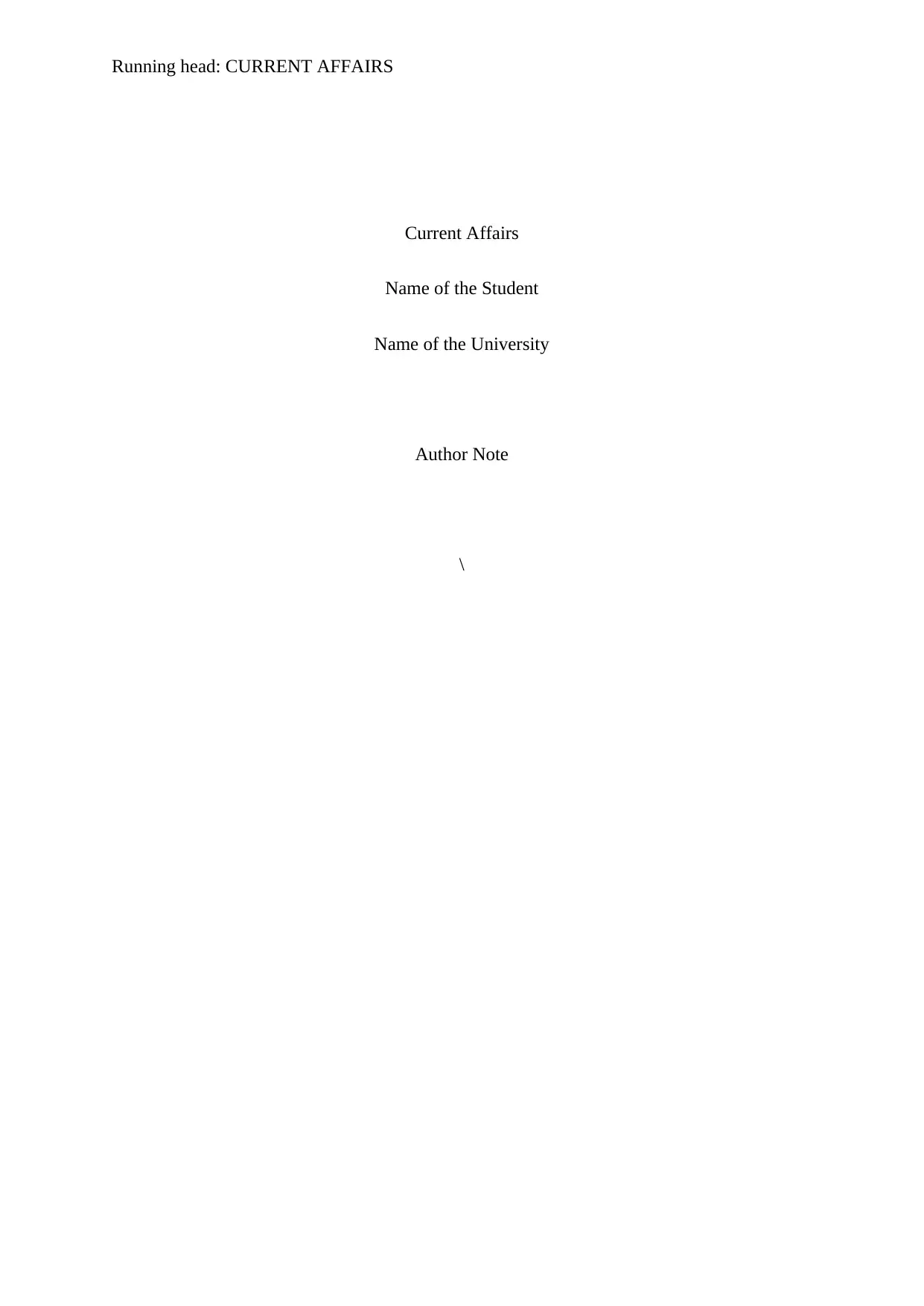
Running head: CURRENT AFFAIRS
Current Affairs
Name of the Student
Name of the University
Author Note
\
Current Affairs
Name of the Student
Name of the University
Author Note
\
Paraphrase This Document
Need a fresh take? Get an instant paraphrase of this document with our AI Paraphraser
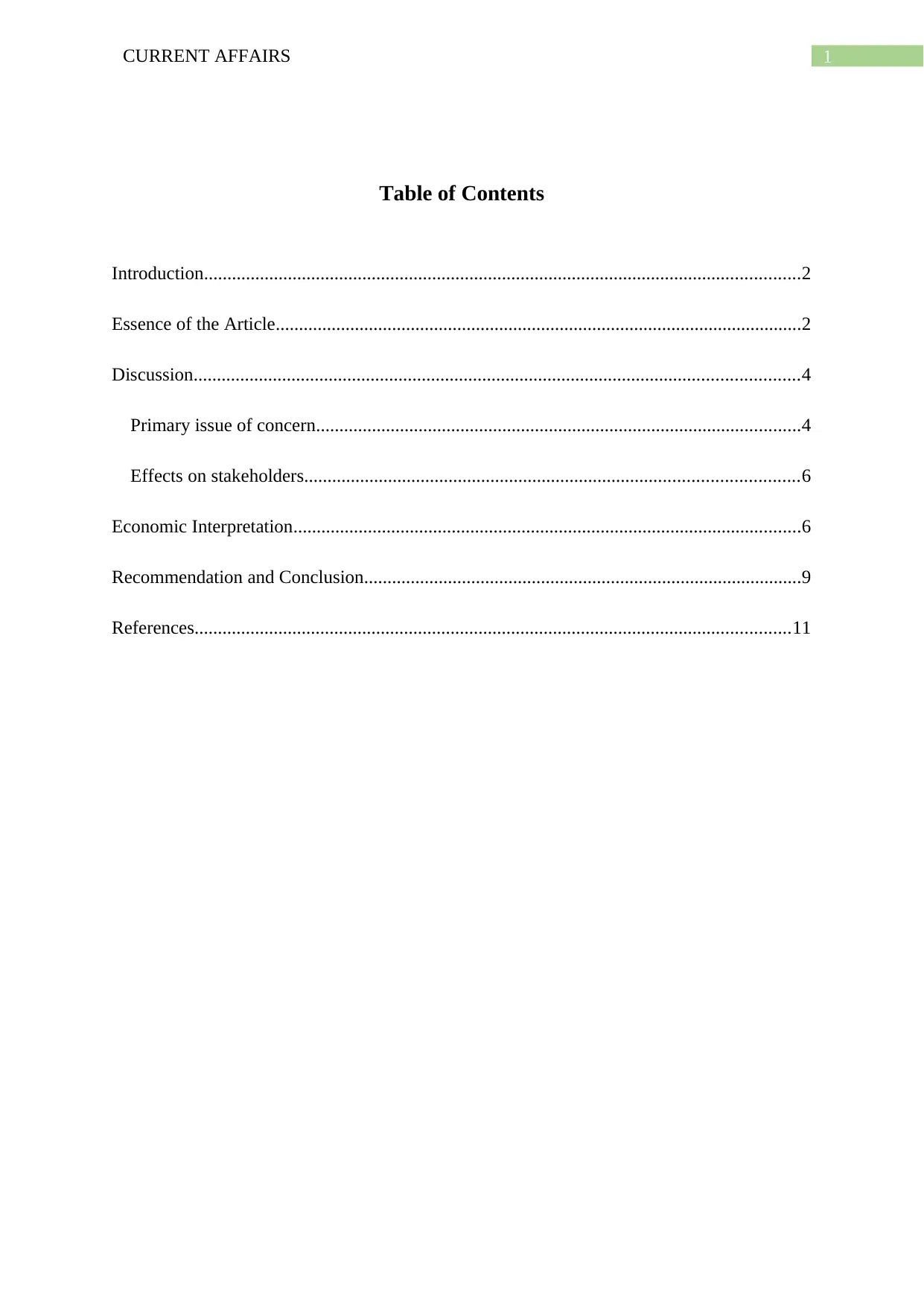
1CURRENT AFFAIRS
Table of Contents
Introduction................................................................................................................................2
Essence of the Article.................................................................................................................2
Discussion..................................................................................................................................4
Primary issue of concern........................................................................................................4
Effects on stakeholders..........................................................................................................6
Economic Interpretation.............................................................................................................6
Recommendation and Conclusion..............................................................................................9
References................................................................................................................................11
Table of Contents
Introduction................................................................................................................................2
Essence of the Article.................................................................................................................2
Discussion..................................................................................................................................4
Primary issue of concern........................................................................................................4
Effects on stakeholders..........................................................................................................6
Economic Interpretation.............................................................................................................6
Recommendation and Conclusion..............................................................................................9
References................................................................................................................................11
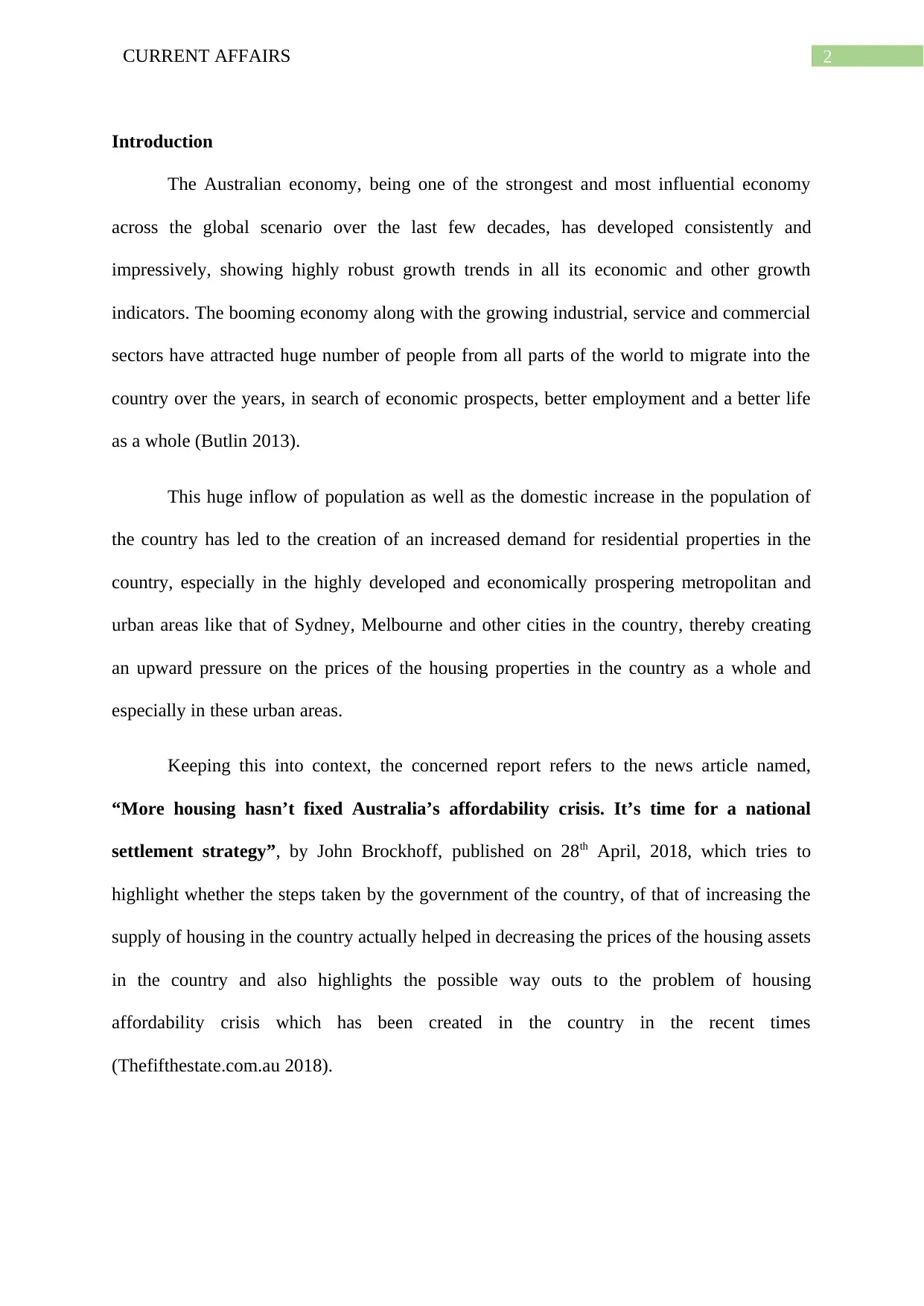
2CURRENT AFFAIRS
Introduction
The Australian economy, being one of the strongest and most influential economy
across the global scenario over the last few decades, has developed consistently and
impressively, showing highly robust growth trends in all its economic and other growth
indicators. The booming economy along with the growing industrial, service and commercial
sectors have attracted huge number of people from all parts of the world to migrate into the
country over the years, in search of economic prospects, better employment and a better life
as a whole (Butlin 2013).
This huge inflow of population as well as the domestic increase in the population of
the country has led to the creation of an increased demand for residential properties in the
country, especially in the highly developed and economically prospering metropolitan and
urban areas like that of Sydney, Melbourne and other cities in the country, thereby creating
an upward pressure on the prices of the housing properties in the country as a whole and
especially in these urban areas.
Keeping this into context, the concerned report refers to the news article named,
“More housing hasn’t fixed Australia’s affordability crisis. It’s time for a national
settlement strategy”, by John Brockhoff, published on 28th April, 2018, which tries to
highlight whether the steps taken by the government of the country, of that of increasing the
supply of housing in the country actually helped in decreasing the prices of the housing assets
in the country and also highlights the possible way outs to the problem of housing
affordability crisis which has been created in the country in the recent times
(Thefifthestate.com.au 2018).
Introduction
The Australian economy, being one of the strongest and most influential economy
across the global scenario over the last few decades, has developed consistently and
impressively, showing highly robust growth trends in all its economic and other growth
indicators. The booming economy along with the growing industrial, service and commercial
sectors have attracted huge number of people from all parts of the world to migrate into the
country over the years, in search of economic prospects, better employment and a better life
as a whole (Butlin 2013).
This huge inflow of population as well as the domestic increase in the population of
the country has led to the creation of an increased demand for residential properties in the
country, especially in the highly developed and economically prospering metropolitan and
urban areas like that of Sydney, Melbourne and other cities in the country, thereby creating
an upward pressure on the prices of the housing properties in the country as a whole and
especially in these urban areas.
Keeping this into context, the concerned report refers to the news article named,
“More housing hasn’t fixed Australia’s affordability crisis. It’s time for a national
settlement strategy”, by John Brockhoff, published on 28th April, 2018, which tries to
highlight whether the steps taken by the government of the country, of that of increasing the
supply of housing in the country actually helped in decreasing the prices of the housing assets
in the country and also highlights the possible way outs to the problem of housing
affordability crisis which has been created in the country in the recent times
(Thefifthestate.com.au 2018).
⊘ This is a preview!⊘
Do you want full access?
Subscribe today to unlock all pages.

Trusted by 1+ million students worldwide
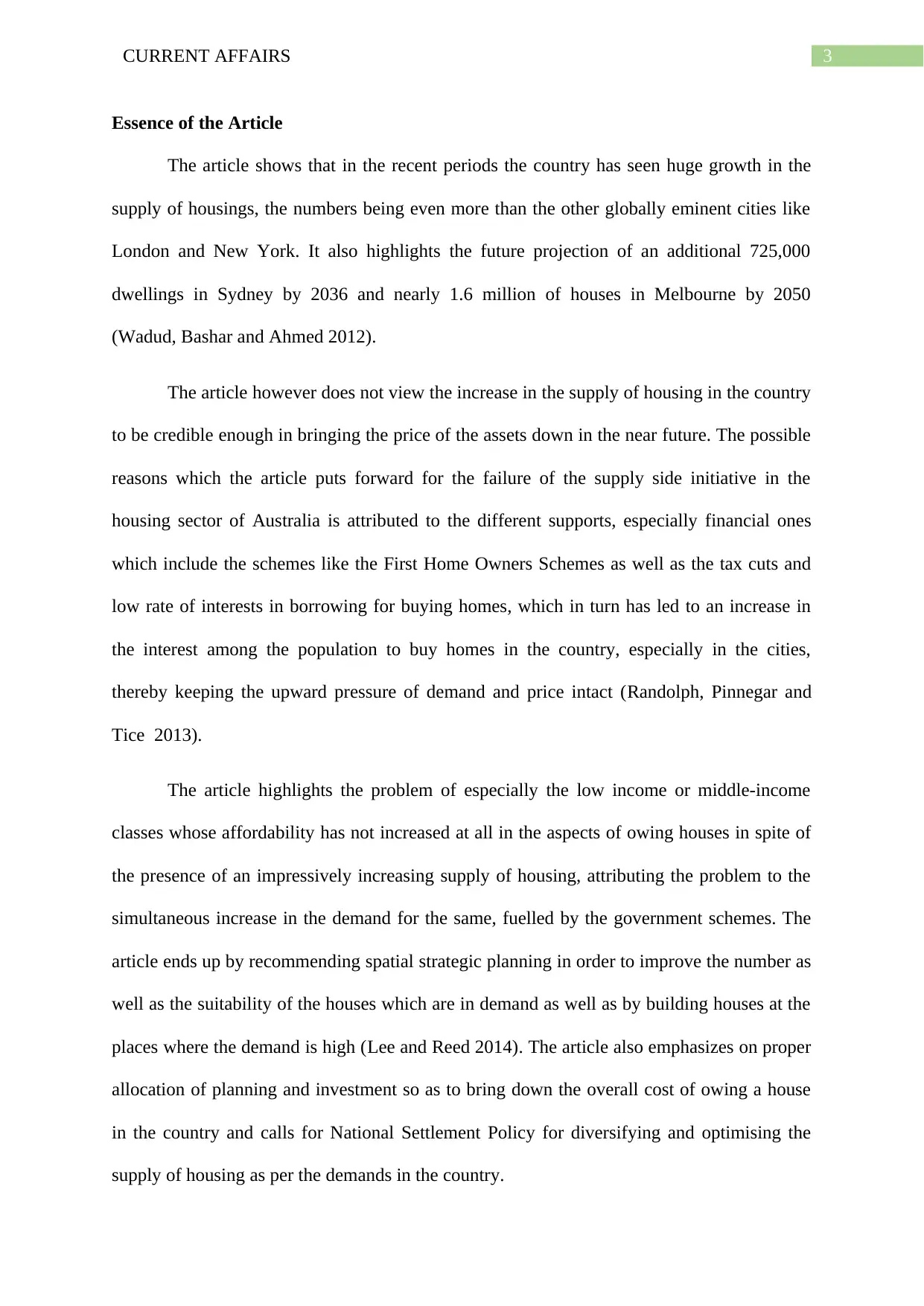
3CURRENT AFFAIRS
Essence of the Article
The article shows that in the recent periods the country has seen huge growth in the
supply of housings, the numbers being even more than the other globally eminent cities like
London and New York. It also highlights the future projection of an additional 725,000
dwellings in Sydney by 2036 and nearly 1.6 million of houses in Melbourne by 2050
(Wadud, Bashar and Ahmed 2012).
The article however does not view the increase in the supply of housing in the country
to be credible enough in bringing the price of the assets down in the near future. The possible
reasons which the article puts forward for the failure of the supply side initiative in the
housing sector of Australia is attributed to the different supports, especially financial ones
which include the schemes like the First Home Owners Schemes as well as the tax cuts and
low rate of interests in borrowing for buying homes, which in turn has led to an increase in
the interest among the population to buy homes in the country, especially in the cities,
thereby keeping the upward pressure of demand and price intact (Randolph, Pinnegar and
Tice 2013).
The article highlights the problem of especially the low income or middle-income
classes whose affordability has not increased at all in the aspects of owing houses in spite of
the presence of an impressively increasing supply of housing, attributing the problem to the
simultaneous increase in the demand for the same, fuelled by the government schemes. The
article ends up by recommending spatial strategic planning in order to improve the number as
well as the suitability of the houses which are in demand as well as by building houses at the
places where the demand is high (Lee and Reed 2014). The article also emphasizes on proper
allocation of planning and investment so as to bring down the overall cost of owing a house
in the country and calls for National Settlement Policy for diversifying and optimising the
supply of housing as per the demands in the country.
Essence of the Article
The article shows that in the recent periods the country has seen huge growth in the
supply of housings, the numbers being even more than the other globally eminent cities like
London and New York. It also highlights the future projection of an additional 725,000
dwellings in Sydney by 2036 and nearly 1.6 million of houses in Melbourne by 2050
(Wadud, Bashar and Ahmed 2012).
The article however does not view the increase in the supply of housing in the country
to be credible enough in bringing the price of the assets down in the near future. The possible
reasons which the article puts forward for the failure of the supply side initiative in the
housing sector of Australia is attributed to the different supports, especially financial ones
which include the schemes like the First Home Owners Schemes as well as the tax cuts and
low rate of interests in borrowing for buying homes, which in turn has led to an increase in
the interest among the population to buy homes in the country, especially in the cities,
thereby keeping the upward pressure of demand and price intact (Randolph, Pinnegar and
Tice 2013).
The article highlights the problem of especially the low income or middle-income
classes whose affordability has not increased at all in the aspects of owing houses in spite of
the presence of an impressively increasing supply of housing, attributing the problem to the
simultaneous increase in the demand for the same, fuelled by the government schemes. The
article ends up by recommending spatial strategic planning in order to improve the number as
well as the suitability of the houses which are in demand as well as by building houses at the
places where the demand is high (Lee and Reed 2014). The article also emphasizes on proper
allocation of planning and investment so as to bring down the overall cost of owing a house
in the country and calls for National Settlement Policy for diversifying and optimising the
supply of housing as per the demands in the country.
Paraphrase This Document
Need a fresh take? Get an instant paraphrase of this document with our AI Paraphraser
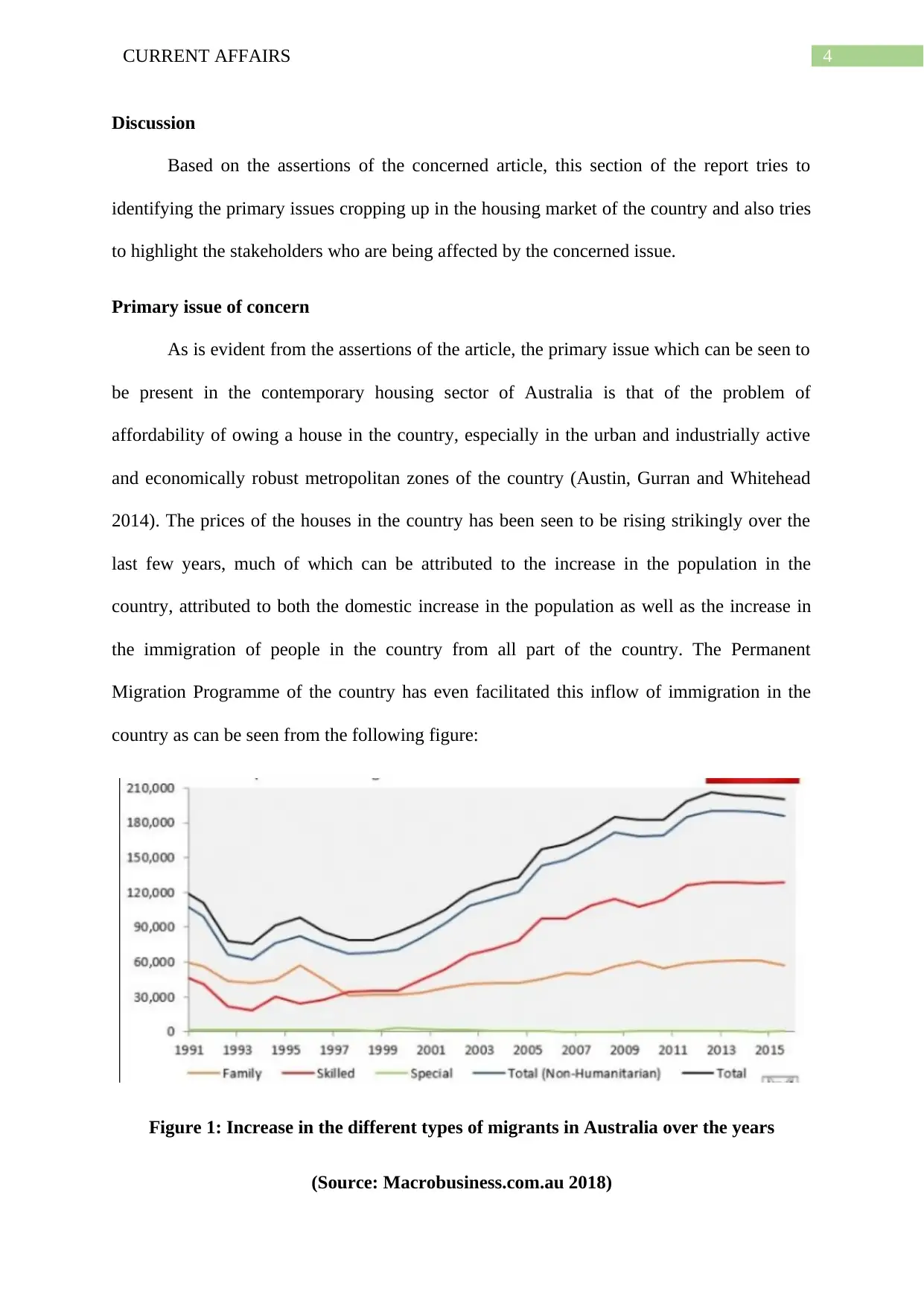
4CURRENT AFFAIRS
Discussion
Based on the assertions of the concerned article, this section of the report tries to
identifying the primary issues cropping up in the housing market of the country and also tries
to highlight the stakeholders who are being affected by the concerned issue.
Primary issue of concern
As is evident from the assertions of the article, the primary issue which can be seen to
be present in the contemporary housing sector of Australia is that of the problem of
affordability of owing a house in the country, especially in the urban and industrially active
and economically robust metropolitan zones of the country (Austin, Gurran and Whitehead
2014). The prices of the houses in the country has been seen to be rising strikingly over the
last few years, much of which can be attributed to the increase in the population in the
country, attributed to both the domestic increase in the population as well as the increase in
the immigration of people in the country from all part of the country. The Permanent
Migration Programme of the country has even facilitated this inflow of immigration in the
country as can be seen from the following figure:
Figure 1: Increase in the different types of migrants in Australia over the years
(Source: Macrobusiness.com.au 2018)
Discussion
Based on the assertions of the concerned article, this section of the report tries to
identifying the primary issues cropping up in the housing market of the country and also tries
to highlight the stakeholders who are being affected by the concerned issue.
Primary issue of concern
As is evident from the assertions of the article, the primary issue which can be seen to
be present in the contemporary housing sector of Australia is that of the problem of
affordability of owing a house in the country, especially in the urban and industrially active
and economically robust metropolitan zones of the country (Austin, Gurran and Whitehead
2014). The prices of the houses in the country has been seen to be rising strikingly over the
last few years, much of which can be attributed to the increase in the population in the
country, attributed to both the domestic increase in the population as well as the increase in
the immigration of people in the country from all part of the country. The Permanent
Migration Programme of the country has even facilitated this inflow of immigration in the
country as can be seen from the following figure:
Figure 1: Increase in the different types of migrants in Australia over the years
(Source: Macrobusiness.com.au 2018)
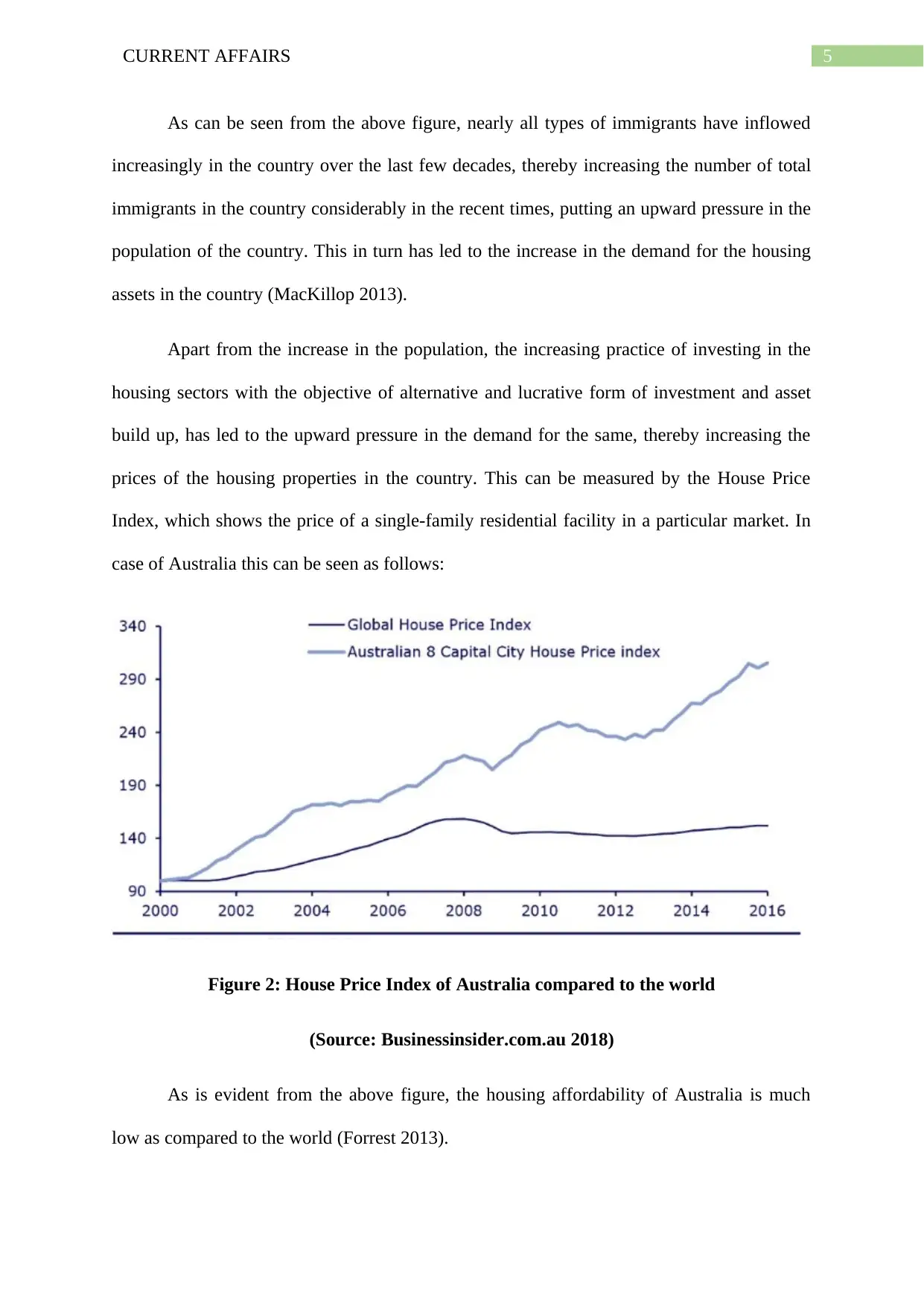
5CURRENT AFFAIRS
As can be seen from the above figure, nearly all types of immigrants have inflowed
increasingly in the country over the last few decades, thereby increasing the number of total
immigrants in the country considerably in the recent times, putting an upward pressure in the
population of the country. This in turn has led to the increase in the demand for the housing
assets in the country (MacKillop 2013).
Apart from the increase in the population, the increasing practice of investing in the
housing sectors with the objective of alternative and lucrative form of investment and asset
build up, has led to the upward pressure in the demand for the same, thereby increasing the
prices of the housing properties in the country. This can be measured by the House Price
Index, which shows the price of a single-family residential facility in a particular market. In
case of Australia this can be seen as follows:
Figure 2: House Price Index of Australia compared to the world
(Source: Businessinsider.com.au 2018)
As is evident from the above figure, the housing affordability of Australia is much
low as compared to the world (Forrest 2013).
As can be seen from the above figure, nearly all types of immigrants have inflowed
increasingly in the country over the last few decades, thereby increasing the number of total
immigrants in the country considerably in the recent times, putting an upward pressure in the
population of the country. This in turn has led to the increase in the demand for the housing
assets in the country (MacKillop 2013).
Apart from the increase in the population, the increasing practice of investing in the
housing sectors with the objective of alternative and lucrative form of investment and asset
build up, has led to the upward pressure in the demand for the same, thereby increasing the
prices of the housing properties in the country. This can be measured by the House Price
Index, which shows the price of a single-family residential facility in a particular market. In
case of Australia this can be seen as follows:
Figure 2: House Price Index of Australia compared to the world
(Source: Businessinsider.com.au 2018)
As is evident from the above figure, the housing affordability of Australia is much
low as compared to the world (Forrest 2013).
⊘ This is a preview!⊘
Do you want full access?
Subscribe today to unlock all pages.

Trusted by 1+ million students worldwide
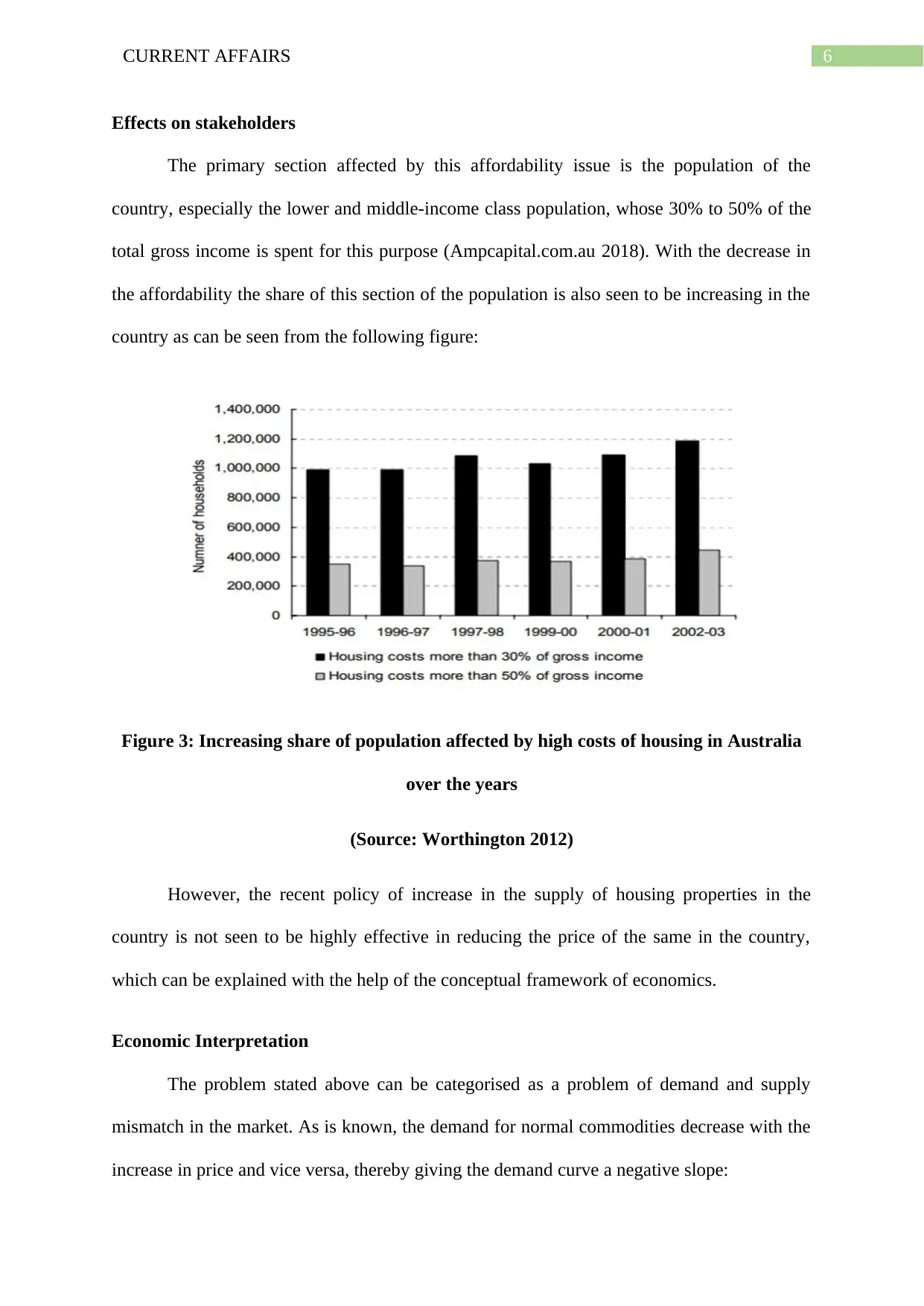
6CURRENT AFFAIRS
Effects on stakeholders
The primary section affected by this affordability issue is the population of the
country, especially the lower and middle-income class population, whose 30% to 50% of the
total gross income is spent for this purpose (Ampcapital.com.au 2018). With the decrease in
the affordability the share of this section of the population is also seen to be increasing in the
country as can be seen from the following figure:
Figure 3: Increasing share of population affected by high costs of housing in Australia
over the years
(Source: Worthington 2012)
However, the recent policy of increase in the supply of housing properties in the
country is not seen to be highly effective in reducing the price of the same in the country,
which can be explained with the help of the conceptual framework of economics.
Economic Interpretation
The problem stated above can be categorised as a problem of demand and supply
mismatch in the market. As is known, the demand for normal commodities decrease with the
increase in price and vice versa, thereby giving the demand curve a negative slope:
Effects on stakeholders
The primary section affected by this affordability issue is the population of the
country, especially the lower and middle-income class population, whose 30% to 50% of the
total gross income is spent for this purpose (Ampcapital.com.au 2018). With the decrease in
the affordability the share of this section of the population is also seen to be increasing in the
country as can be seen from the following figure:
Figure 3: Increasing share of population affected by high costs of housing in Australia
over the years
(Source: Worthington 2012)
However, the recent policy of increase in the supply of housing properties in the
country is not seen to be highly effective in reducing the price of the same in the country,
which can be explained with the help of the conceptual framework of economics.
Economic Interpretation
The problem stated above can be categorised as a problem of demand and supply
mismatch in the market. As is known, the demand for normal commodities decrease with the
increase in price and vice versa, thereby giving the demand curve a negative slope:
Paraphrase This Document
Need a fresh take? Get an instant paraphrase of this document with our AI Paraphraser
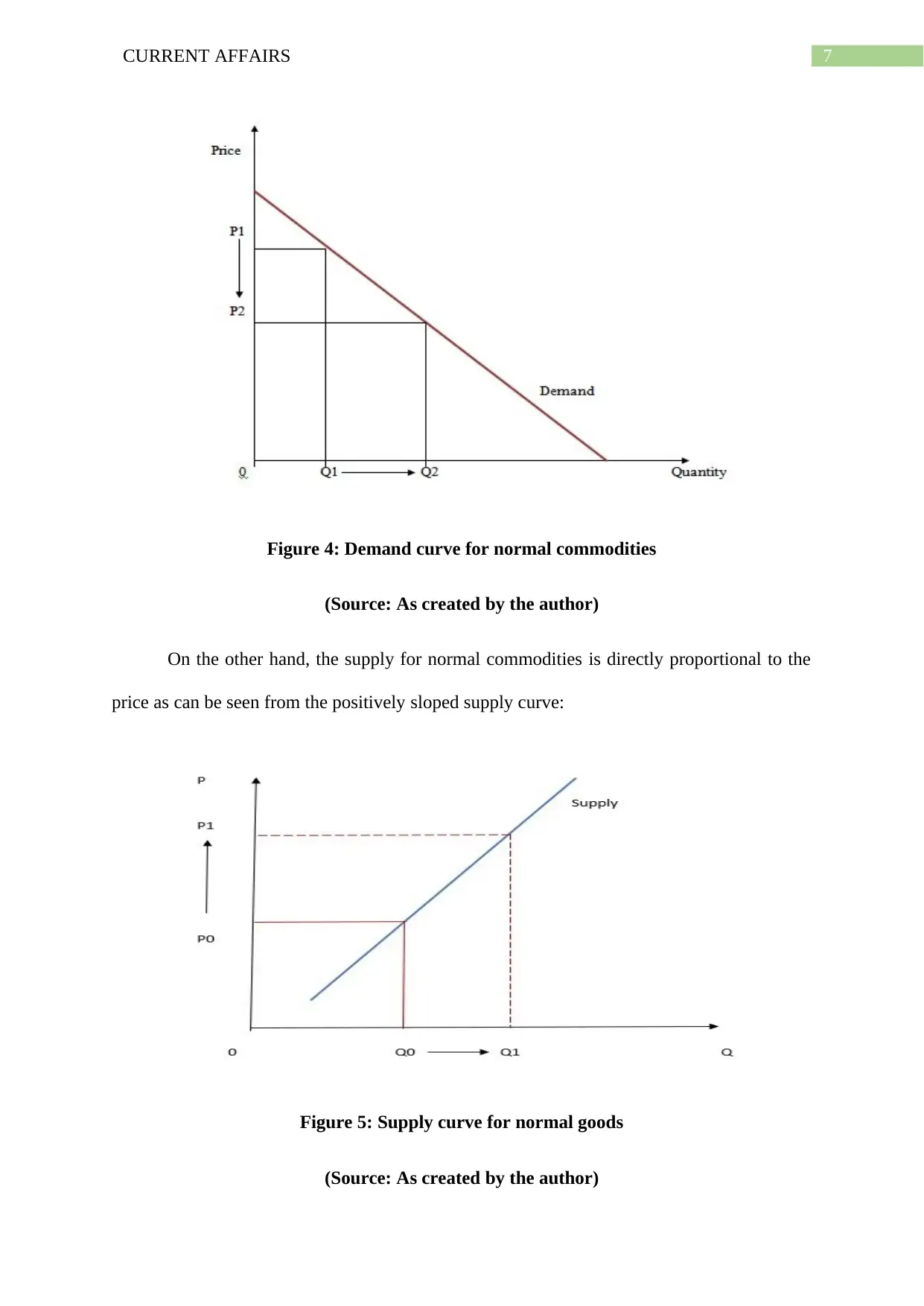
7CURRENT AFFAIRS
Figure 4: Demand curve for normal commodities
(Source: As created by the author)
On the other hand, the supply for normal commodities is directly proportional to the
price as can be seen from the positively sloped supply curve:
Figure 5: Supply curve for normal goods
(Source: As created by the author)
Figure 4: Demand curve for normal commodities
(Source: As created by the author)
On the other hand, the supply for normal commodities is directly proportional to the
price as can be seen from the positively sloped supply curve:
Figure 5: Supply curve for normal goods
(Source: As created by the author)
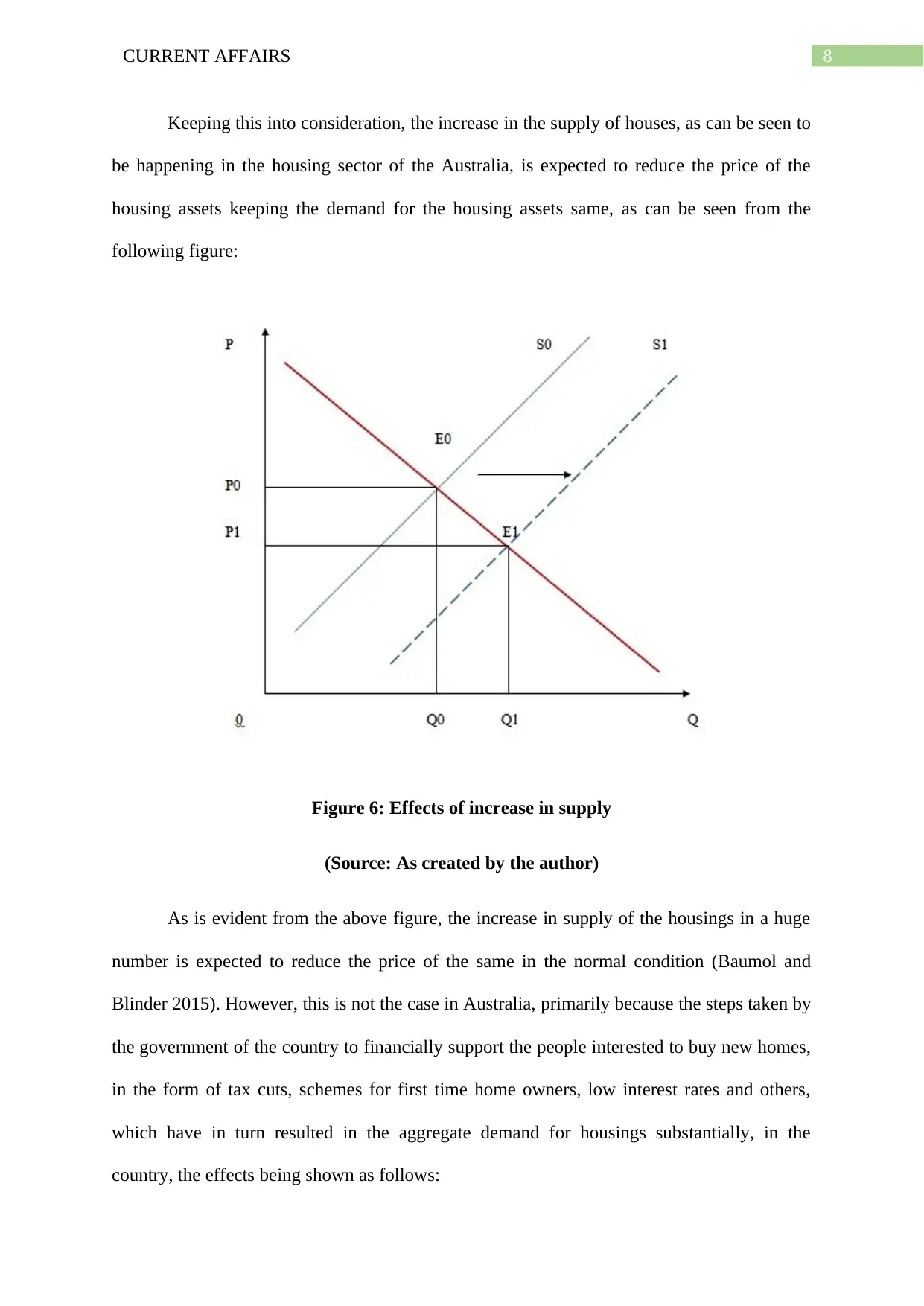
8CURRENT AFFAIRS
Keeping this into consideration, the increase in the supply of houses, as can be seen to
be happening in the housing sector of the Australia, is expected to reduce the price of the
housing assets keeping the demand for the housing assets same, as can be seen from the
following figure:
Figure 6: Effects of increase in supply
(Source: As created by the author)
As is evident from the above figure, the increase in supply of the housings in a huge
number is expected to reduce the price of the same in the normal condition (Baumol and
Blinder 2015). However, this is not the case in Australia, primarily because the steps taken by
the government of the country to financially support the people interested to buy new homes,
in the form of tax cuts, schemes for first time home owners, low interest rates and others,
which have in turn resulted in the aggregate demand for housings substantially, in the
country, the effects being shown as follows:
Keeping this into consideration, the increase in the supply of houses, as can be seen to
be happening in the housing sector of the Australia, is expected to reduce the price of the
housing assets keeping the demand for the housing assets same, as can be seen from the
following figure:
Figure 6: Effects of increase in supply
(Source: As created by the author)
As is evident from the above figure, the increase in supply of the housings in a huge
number is expected to reduce the price of the same in the normal condition (Baumol and
Blinder 2015). However, this is not the case in Australia, primarily because the steps taken by
the government of the country to financially support the people interested to buy new homes,
in the form of tax cuts, schemes for first time home owners, low interest rates and others,
which have in turn resulted in the aggregate demand for housings substantially, in the
country, the effects being shown as follows:
⊘ This is a preview!⊘
Do you want full access?
Subscribe today to unlock all pages.

Trusted by 1+ million students worldwide
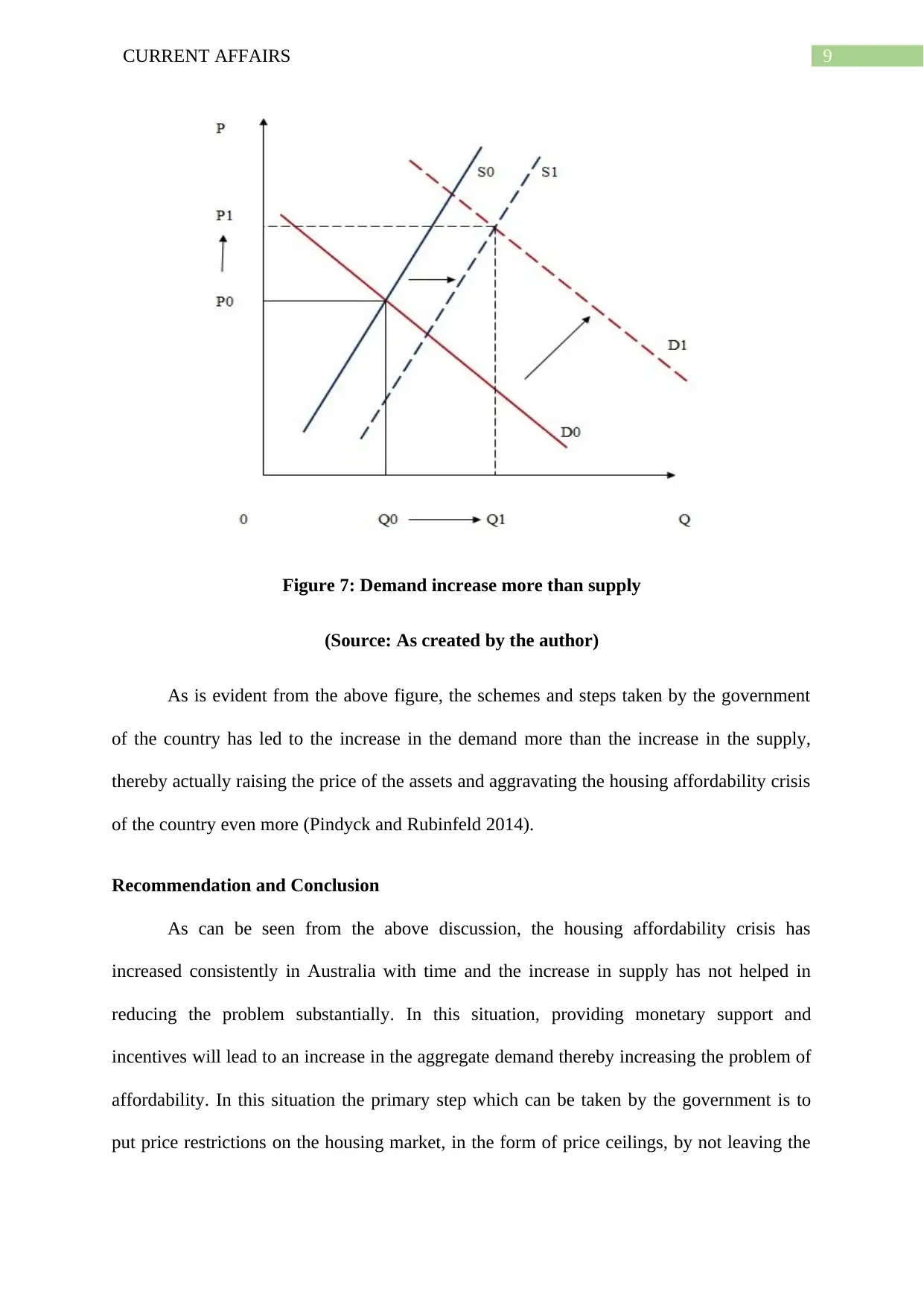
9CURRENT AFFAIRS
Figure 7: Demand increase more than supply
(Source: As created by the author)
As is evident from the above figure, the schemes and steps taken by the government
of the country has led to the increase in the demand more than the increase in the supply,
thereby actually raising the price of the assets and aggravating the housing affordability crisis
of the country even more (Pindyck and Rubinfeld 2014).
Recommendation and Conclusion
As can be seen from the above discussion, the housing affordability crisis has
increased consistently in Australia with time and the increase in supply has not helped in
reducing the problem substantially. In this situation, providing monetary support and
incentives will lead to an increase in the aggregate demand thereby increasing the problem of
affordability. In this situation the primary step which can be taken by the government is to
put price restrictions on the housing market, in the form of price ceilings, by not leaving the
Figure 7: Demand increase more than supply
(Source: As created by the author)
As is evident from the above figure, the schemes and steps taken by the government
of the country has led to the increase in the demand more than the increase in the supply,
thereby actually raising the price of the assets and aggravating the housing affordability crisis
of the country even more (Pindyck and Rubinfeld 2014).
Recommendation and Conclusion
As can be seen from the above discussion, the housing affordability crisis has
increased consistently in Australia with time and the increase in supply has not helped in
reducing the problem substantially. In this situation, providing monetary support and
incentives will lead to an increase in the aggregate demand thereby increasing the problem of
affordability. In this situation the primary step which can be taken by the government is to
put price restrictions on the housing market, in the form of price ceilings, by not leaving the
Paraphrase This Document
Need a fresh take? Get an instant paraphrase of this document with our AI Paraphraser

10CURRENT AFFAIRS
price entirely in the hands of the market itself. The government should also induce the
suppliers to increase the numbers of budget housings so as to benefit the lower and middle-
income class of the country, who has been the worst hit of the housing affordability crisis in
Australia.
price entirely in the hands of the market itself. The government should also induce the
suppliers to increase the numbers of budget housings so as to benefit the lower and middle-
income class of the country, who has been the worst hit of the housing affordability crisis in
Australia.
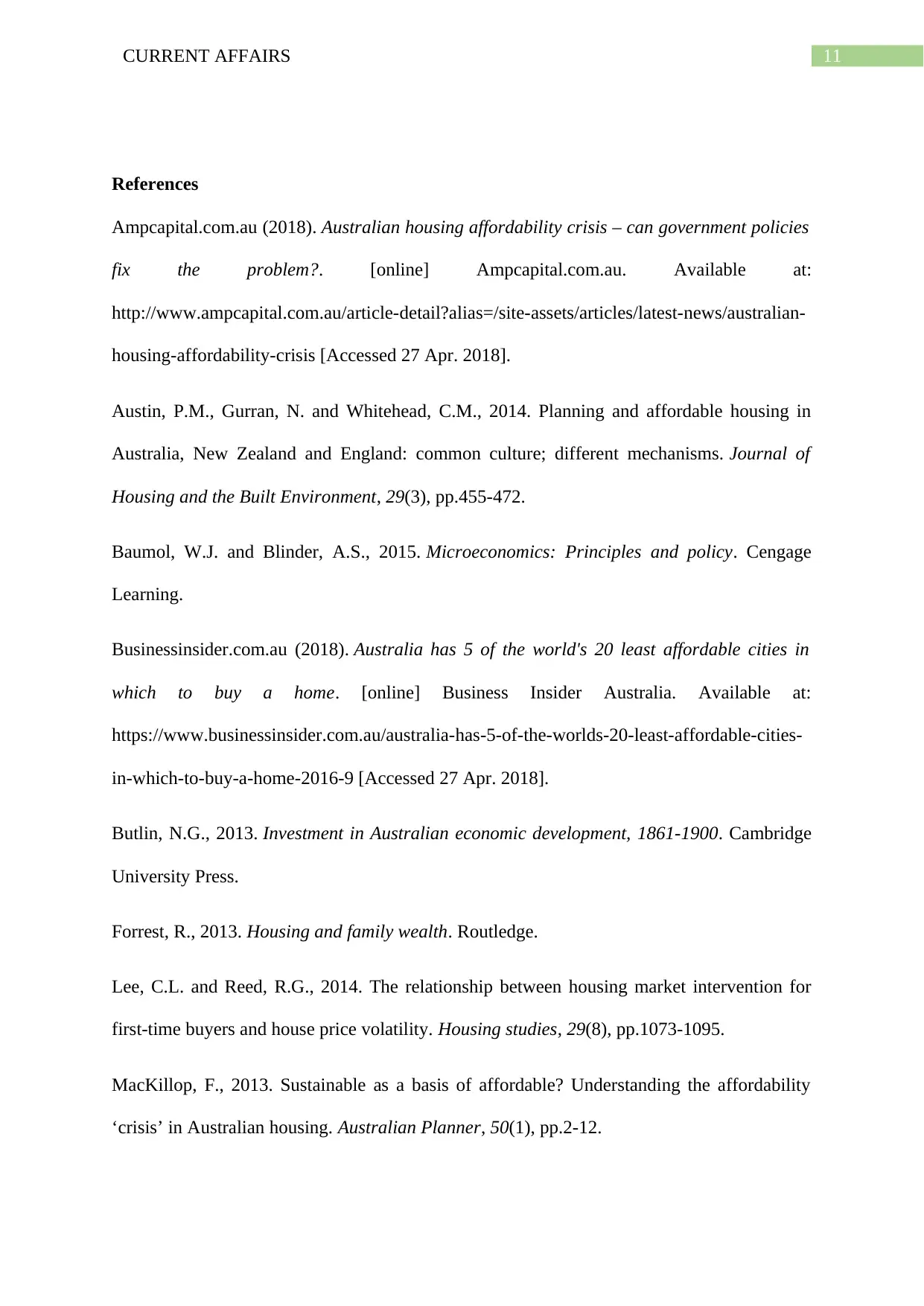
11CURRENT AFFAIRS
References
Ampcapital.com.au (2018). Australian housing affordability crisis – can government policies
fix the problem?. [online] Ampcapital.com.au. Available at:
http://www.ampcapital.com.au/article-detail?alias=/site-assets/articles/latest-news/australian-
housing-affordability-crisis [Accessed 27 Apr. 2018].
Austin, P.M., Gurran, N. and Whitehead, C.M., 2014. Planning and affordable housing in
Australia, New Zealand and England: common culture; different mechanisms. Journal of
Housing and the Built Environment, 29(3), pp.455-472.
Baumol, W.J. and Blinder, A.S., 2015. Microeconomics: Principles and policy. Cengage
Learning.
Businessinsider.com.au (2018). Australia has 5 of the world's 20 least affordable cities in
which to buy a home. [online] Business Insider Australia. Available at:
https://www.businessinsider.com.au/australia-has-5-of-the-worlds-20-least-affordable-cities-
in-which-to-buy-a-home-2016-9 [Accessed 27 Apr. 2018].
Butlin, N.G., 2013. Investment in Australian economic development, 1861-1900. Cambridge
University Press.
Forrest, R., 2013. Housing and family wealth. Routledge.
Lee, C.L. and Reed, R.G., 2014. The relationship between housing market intervention for
first-time buyers and house price volatility. Housing studies, 29(8), pp.1073-1095.
MacKillop, F., 2013. Sustainable as a basis of affordable? Understanding the affordability
‘crisis’ in Australian housing. Australian Planner, 50(1), pp.2-12.
References
Ampcapital.com.au (2018). Australian housing affordability crisis – can government policies
fix the problem?. [online] Ampcapital.com.au. Available at:
http://www.ampcapital.com.au/article-detail?alias=/site-assets/articles/latest-news/australian-
housing-affordability-crisis [Accessed 27 Apr. 2018].
Austin, P.M., Gurran, N. and Whitehead, C.M., 2014. Planning and affordable housing in
Australia, New Zealand and England: common culture; different mechanisms. Journal of
Housing and the Built Environment, 29(3), pp.455-472.
Baumol, W.J. and Blinder, A.S., 2015. Microeconomics: Principles and policy. Cengage
Learning.
Businessinsider.com.au (2018). Australia has 5 of the world's 20 least affordable cities in
which to buy a home. [online] Business Insider Australia. Available at:
https://www.businessinsider.com.au/australia-has-5-of-the-worlds-20-least-affordable-cities-
in-which-to-buy-a-home-2016-9 [Accessed 27 Apr. 2018].
Butlin, N.G., 2013. Investment in Australian economic development, 1861-1900. Cambridge
University Press.
Forrest, R., 2013. Housing and family wealth. Routledge.
Lee, C.L. and Reed, R.G., 2014. The relationship between housing market intervention for
first-time buyers and house price volatility. Housing studies, 29(8), pp.1073-1095.
MacKillop, F., 2013. Sustainable as a basis of affordable? Understanding the affordability
‘crisis’ in Australian housing. Australian Planner, 50(1), pp.2-12.
⊘ This is a preview!⊘
Do you want full access?
Subscribe today to unlock all pages.

Trusted by 1+ million students worldwide
1 out of 13
Related Documents
Your All-in-One AI-Powered Toolkit for Academic Success.
+13062052269
info@desklib.com
Available 24*7 on WhatsApp / Email
![[object Object]](/_next/static/media/star-bottom.7253800d.svg)
Unlock your academic potential
Copyright © 2020–2025 A2Z Services. All Rights Reserved. Developed and managed by ZUCOL.




